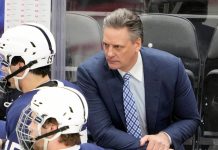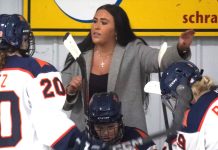Each season, the NCAA Men’s and Women’s Ice Hockey Rules Committee releases an officiating directive, outlining points of emphasis for the coming season. USCHO.com presents this in the interest of making fans more knowledgeable about the game and its officiating.
INDIANAPOLIS – The NCAA Men’s and Women’s Ice Hockey Rules Committee, in conjunction with the conference commissioners of the six Division I ice hockey conferences, released the 2006-07 officiating directive, which urges continued diligence in officiating the rules as written and continuing to change the culture of ice hockey.
This season, the committee reaffirms the same principles that were in place the past two years, but also focuses on embellishment fouls, which have the potential to undermine the directive.
“We have been very pleased with the overall effect the directive has had on the game,” said Col. James Knowlton, chair of the Ice Hockey Rules Committee and director of the center for enhanced performance at the United States Military Academy. “The plan is to continue to enforce this initiative and reward gained advantages by offensive players.”
The commissioners of the six conferences all expressed support for the continued enforcement of the statement made prior to the season.
“It’s very important that we sustain the positive developments in the game accomplished in the last two years,” said Joe Bertagna, commissioner of the Hockey East Association. “All parties involved – coaches, players, officials and fans – have made adjustments, and our game is better for it.”
2006-07 Directive to the NCAA Ice Hockey Community
Background At the start of the 2004-05 college hockey season, the NCAA Men’s and Women’s Ice Hockey Rules Committee, the College Hockey Commissioners and Supervisors, and members of the NCAA Staff took unprecedented measures to encourage proper enforcement of on-ice playing rules. Specifically, this group, acting in harmony and with full consensus, identified specific on-ice situations where obstruction and interference had been allowed to flourish in recent years. Coaches and players alike were alerted to new standards in these areas and officials were issued a mandate to call penalties where these violations occurred. All the affected parties accepted the 2004-05 mandate and the on-ice game was better for it.
At the start of the 2005-06 season, the directive was re-affirmed and distributed to the college hockey community once more. Added to the letter was a section on “Situational Standards.” This refers to the practice of adjusting one’s standard or expectation for a specific situation (i.e., late in a close game, when a team is already shorthanded, if a team had received a number of penalties in a row, etc.). The message in September of 2005 was that a penalty should be called when the action of a player violates a rule, regardless of the situation.
Now, on the eve of the 2006-07 season, a similar directive is being issued. In short, it reaffirms the intentions of the letters sent out in each of the past two seasons. The college hockey community, which began the process of “reclaiming our rule book” two years ago, urges continued adherence to the standard in order to maintain and improve the progress made the past two seasons.
As most know, the National Hockey League and USA Hockey recently announced their effort to adhere to new standards, for which the NCAA commends those organizations. To be clear, the NCAA directive is not the same as the NHL/USA Hockey directive. Each level has its own rules book and administrative structure. And each level has its own nuances of how their respective games should be called. We all are seeking greater consistency in the enforcement of their respective rules books.
Restating the Purpose of the Directive The stated purpose of this Directive is to allow all players to benefit from the rules book and how the book is called. While the “let them play” philosophy has become deep rooted and the concept of penalty selection has been universally accepted, we believe these philosophies need to be amended. The “you can’t call everything” approach has allowed too many infractions to go without the proper penalty being called and the result has been a less attractive game than we once knew.
Critics of this collective endeavor may suggest we are adding new penalties to an already bloated rules book. We are not adding any new penalties. The book currently has all the penalties needed for a great game to emerge. We are simply calling for the existing book to be called more responsibly.
Target Areas for 2006-2007 We have the same two general target areas for the coming season as identified a year ago:
1) Allowing all players the right to meet their offensive and defensive responsibilities without being held, hooked, or otherwise obstructed.
2) Eliminating “Situational Standards” from our culture; that is, the changing standard of what is or isn’t a penalty depending on the situation in the game (when a team is even strength or shorthanded; when a team has had a number of penalties in a row already called on it; when the game is tied late or in overtime; etc.).
To address Target Area No. 1 above (obstruction and interference), the following situations have been identified: a) Offensive players coming through the neutral or offensive zones being unfairly/illegally held-up while they make a legitimate attempt to get or remain open for a pass from a puck-controlling teammate. b) Offensive players coming through the neutral or offensive zones being unfairly/illegally held-up while they attempt the legitimate pursuit of a loose puck. c) Players along the boards, on or away from the puck, being unfairly/illegally restrained. d) Interference off of face-offs.
Notes: The Rules Committee has identified “Embellishment” as a Point of Emphasis for the coming year. Referees must make every effort to penalize players who attempt to draw penalties through deception. Also, the Rules Committee stressed that referees should pay particular attention to the strength and size of players who may be unduly penalized only because they are larger and/or stronger.
To address Target Area No. 2 above (Situational Standards), the following guidelines are being issued: a) Officials are advised to stay in the present tense; that is, awareness of what situation has already taken place (Team A is shorthanded, Team A has had four straight penalties assessed against them, etc.) or what may take place in the future (a call would create a 5 on 3, a call would create a power play late in the game, etc.) should not influence whether a call should be made or not. b) A non-call can influence a game as much as a call; that is, an official who chooses to be less active late in a closely contested game is potentially influencing the outcome of the game through inaction just as an official who makes calls in that same situation. The official is part of the game and should maintain the same standards from the start of the contest through the end of the contest.
Defining the Standard The NCAA Ice Hockey Rules Book already defines the above actions as penalties. However, we feel that too often these situations are allowed to play out without penalties being called. And so the following standard is again being adopted for the 2006-07 season.
In all of the areas above, we feel that a player who, through the use of physical skill and/or anticipation, has a positional advantage on an opponent, shall not lose that advantage through the illegal use of hands, arms, or stick. Any player in pursuit of a puck or open lane shall not lose a perceived positional advantage by the illegal use of hands, arms, or stick by an opponent. If a player is deprived of that advantage by an illegal act (i.e., hook, hold, interference, etc.) the appropriate penalty must be called.
A “positional advantage,” in other terminology, might be called “a step” as in: “He had a good step on him but the guy hooked him just enough to come up even with him.”
Please note: the illegal acts we are targeting include, but are not necessarily limited to, the following: . Using a free or open hand or arm to restrain an opponent, along the boards (pinning) or in open ice. . Using a free or open hand to grab any part of an opponent’s uniform (tugging), equipment, or stick. . Tying up an opponent by illegal use of hands, arms or stick, rather than by body position. . “Picking” a player who does not have possession of the puck, and, in the process, preventing him or her from moving to open or unoccupied ice in any zone. . Placing the stick between an opponent’s legs, preventing his or her right to participate in the play.
Weathering The Storm For this Directive to work, all parties must know that we are determined to see it through. The standard is what it is. If you take away a player’s legitimate positional advantage through an illegal action, no matter how slight (“a little hook,” “a slight tug,” etc.), it is a penalty. It must be called. And this means:
a) Officials have to understand this and make the call.
b) Supervisors and commissioners must work to stress to their officials that they must make these calls.
c) Officials who show a pattern of not making these calls must pay a price; i.e., lose assignments.
d) Players and coaches have to accept that penalties will result if they continue these practices.
e) Commissioners must respond strongly to coaches who criticize officials who do their job as directed or who criticize this initiative itself.
f) This Directive must be seen through for the entire season.
Conclusion As was the case in the previous two seasons, some resistance to these measures may remain. Two years ago, the on-ice participants accepted the changes more quickly than the general public (media, fans), in part because of early efforts to educate players, coaches, and officials. Last year, even greater acceptance was evident. Regardless of the time it takes to embrace these measures, the NCAA Men’s and Women’s Ice Hockey Rules Committee, the College Hockey Commissioners and Supervisors, and members of the NCAA Staff are committed to seeing them through for the entire season. While it is challenging to tackle customs and expectations embedded in our hockey culture, it can be done. Such is the nature of this collective effort.


